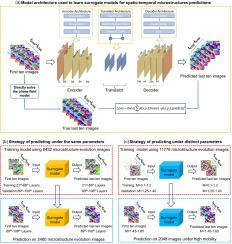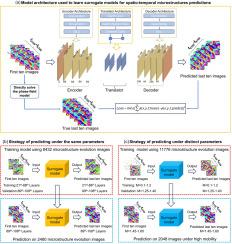基于深度学习的钛合金马氏体相变时空显微组织演化研究
IF 9.3
1区 材料科学
Q1 MATERIALS SCIENCE, MULTIDISCIPLINARY
引用次数: 0
摘要
我们通过基于深度学习的替代模型,解决了使用非均质显微组织的钛合金相场模拟的准确性和效率(速度)问题。通过改变界面迁移率和界面能量,通过高通量相场模拟,首先组装了包含124组3D图像(~ 320,000张2D图像)的数据集。这些数据被用来训练代理模型来“学习”微观结构的时空演变。这些模型通过从前一个时间间隔的相同数量的图像中学习来预测在很宽的时间跨度内的图像。当模型从使用低界面迁移率参数获得的图像中学习以预测具有高迁移率的图像时,这也成立。此外,与针对序列数据设计的典型长短期记忆神经网络相比,该模型在预测图像方面具有精度和效率上的优势,与训练中使用的模型相去甚远。具体来说,对于第4000个进化时间步长的图像,基于像素值的均方误差从0.2755减小到0.065(减小76.4%),而所需的预测时间仅为1/15,即从5.11 s减小到0.38 s。这项工作揭示了使用深度学习工具在不牺牲准确性的情况下加速材料模拟。本文章由计算机程序翻译,如有差异,请以英文原文为准。


Spatiotemporal microstructure evolution during martensitic transformation in titanium alloys using deep learning
We address the issue of accuracy and efficiency (speed) in phase field simulations of titanium alloys using heterogeneous microstructures via deep learning based surrogate models. A data set with 124 groups of 3D images (320,000 2D images) is first assembled via high throughput phase field simulations by varying the interfacial mobility and interfacial energy. The data is used to train surrogate models to “learn” the spatiotemporal evolution of microstructures. These models predict images over a wide time span by learning from the same number of images from the previous time interval. This also holds when the model learns from images obtained using a low interfacial mobility parameter to predict images with high mobility. Moreover, compared to the typical long short-term memory neural network designed for sequential data, the proposed model shows advantages in both accuracy and efficiency, in predictions of images far from those used in training. Specifically, for predicting the image at 4000th evolved time step, the mean squared error based on pixel value is reduced from 0.2755 to 0.065 (a 76.4% reduction) while the prediction time required is only 1/15, i.e., reduced from 5.11 s to 0.38 s. The work sheds light on the use of deep learning tools to accelerate materials simulations without sacrificing accuracy.
求助全文
通过发布文献求助,成功后即可免费获取论文全文。
去求助
来源期刊

Acta Materialia
工程技术-材料科学:综合
CiteScore
16.10
自引率
8.50%
发文量
801
审稿时长
53 days
期刊介绍:
Acta Materialia serves as a platform for publishing full-length, original papers and commissioned overviews that contribute to a profound understanding of the correlation between the processing, structure, and properties of inorganic materials. The journal seeks papers with high impact potential or those that significantly propel the field forward. The scope includes the atomic and molecular arrangements, chemical and electronic structures, and microstructure of materials, focusing on their mechanical or functional behavior across all length scales, including nanostructures.
 求助内容:
求助内容: 应助结果提醒方式:
应助结果提醒方式:


